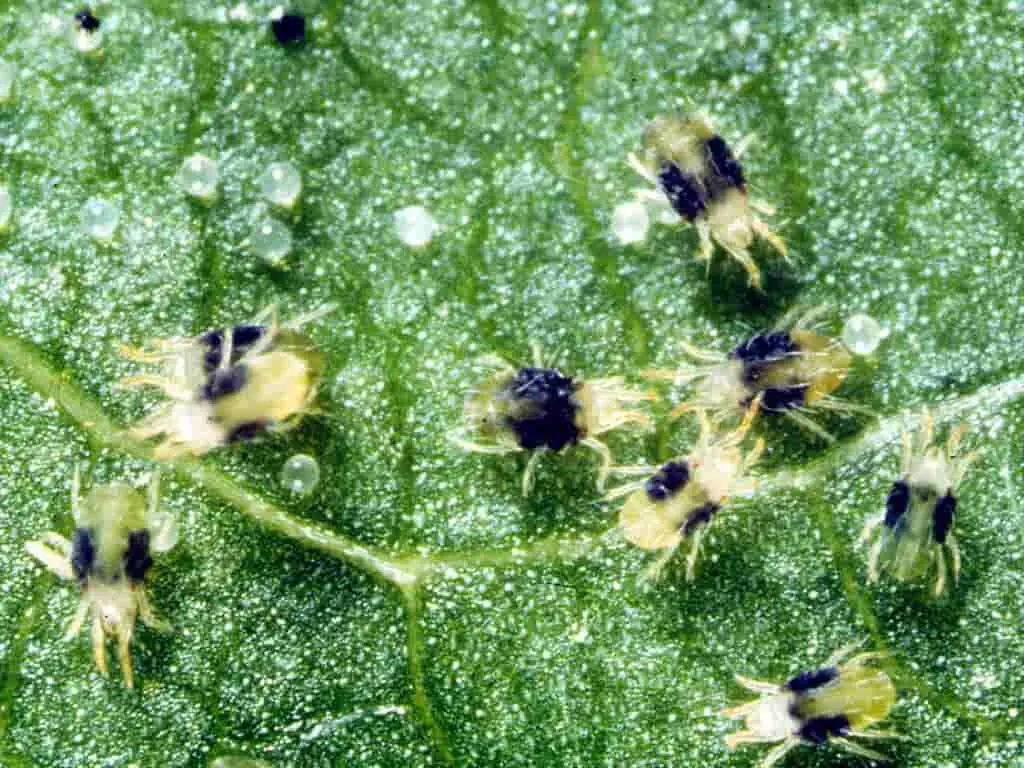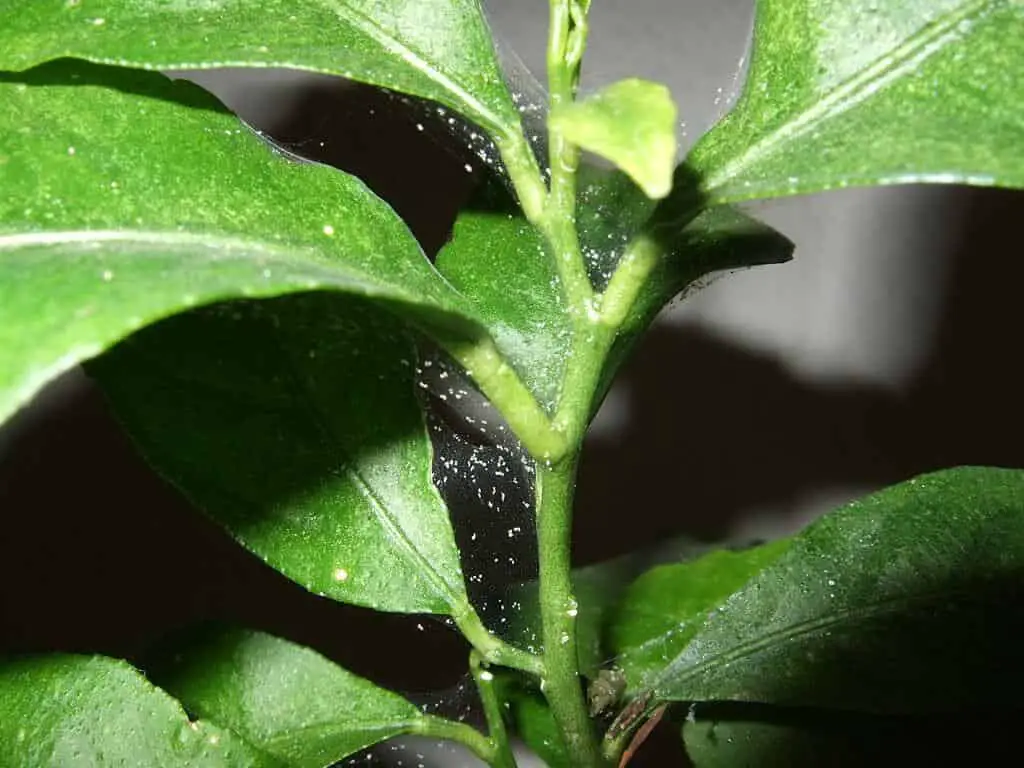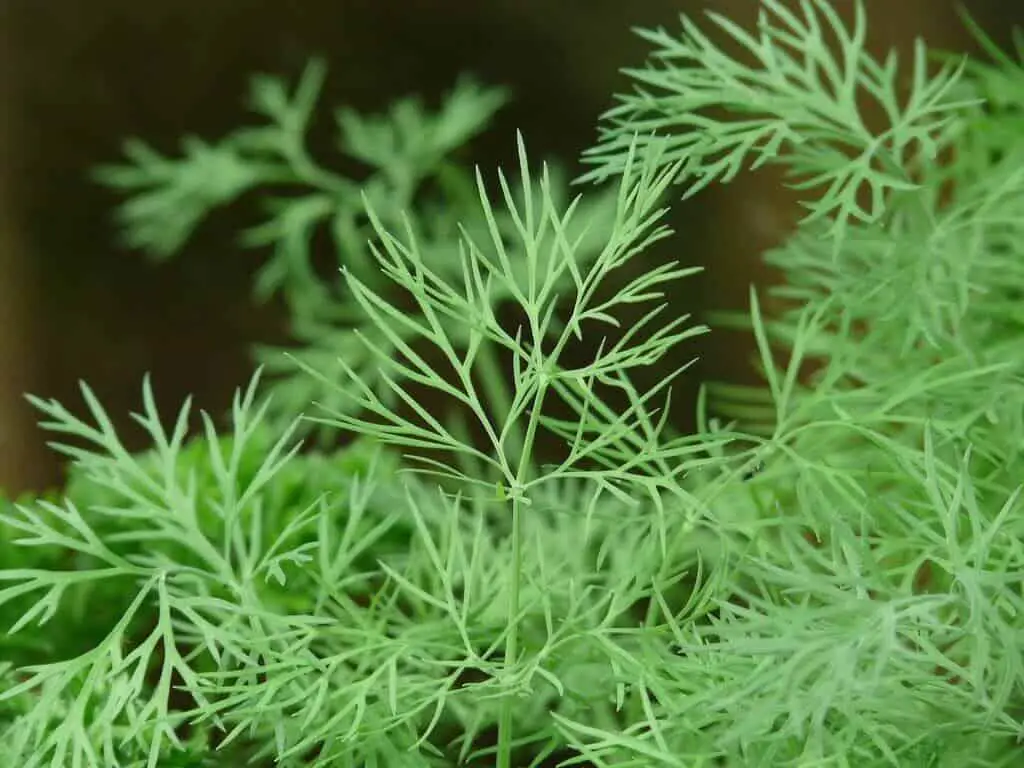What are Spider Mites
Tetranychidae, Acari (mite) family constitutes more than 1,200 species including spider mites. Spider mites are relatives of ticks, spiders, and scorpions. They also have eight legs and similar characteristics as arachnids. Hence, they are classified as a type of arachnids rather than insects.
This article focuses on spider mites, their description, damages, prevention, and treatment.
Spider mites are one of the common garden pests. In fact, their size is smaller than a pin’s head. They measure about 1 mm (0.04 in) long. There are various species of spider mites, appearing in various colors including yellow, green, red, and brown. Among them, red spider mites and two-spotted spider mites are most widely seen in the gardens.
Generally, these pests live in shady areas of plants like the underside of leaves. Sometimes, they also spin protective silk webs to reside in. These pests infect hundreds of species of plants.
Table of Contents
Characteristics

Most Commonly, these pests infect plants in hot and dry climates. These pests start their infection right from spring. Having piercing-sucking mouthparts, they suck out the sap from plants and pierce-extract fluids from leaf tissues.
Typically, the spider mites live building colonies in remote locations like the underside of leaves. They usually spin silky, white webs like spiders for protection.
There are many host plants for these pests including strawberries, tomatoes, beans, melons, and eggplants. Also, most house plants, trees, and some ornamental plants serve as hosts for these pests. Often, these prolific pests inflict more damage, before the plants start to show visible damage.
The usage of insecticides and other chemicals kills natural predators. This facilitates the spreading of mite infections. In fact, some insecticides like carbaryl (Sevin) are found to stimulate the reproduction of mites. These pests can also resist synthetic chemicals. Hence, trying natural, non-toxic remedies is recommended to treat these mites.
Sources of Infection
Spider mites can gain access to your outdoor or indoor plants in various ways.
Purchasing infected unsterile potting soil or infected plants are some of the main sources of infection. They may also spread through winds, infecting your plants, especially in summer.
When you visit local garden centers, these pests can get attached to your clothes. Then, they may spread to your in-house plants through your clothes. When your pets happen to roam near contaminated plants, these pests can travel on their backs to your homes, infecting the indoor plants.
Life Cycle
Generally, spider mites thrive well and proliferate in hot, dry conditions. In warmer regions, these pests continue to lay eggs and infect plants all year round.
However, in colder regions, most species of these pests overwinter as eggs on barks or foliage of the host plants during winters. In the spring, as temperatures rise, the eggs begin to hatch.
Having six legs, emerging tiny larvae feed on the host plants for a few days. Then, they molt into the first nymphs developing eight legs. After that, they go through two more molts, spending a few days for feeding, to mature as adults.
On average, it takes about 5 – 20 days for this cycle to complete. Adults can survive for about four weeks.
After mating, females can lay up to 20 eggs every day. This process continues till the lifetime of the adults. During warm and dry conditions, the life cycles complete in about 5 days. Several generations of these pests overlap each other in a year.
Through winds, these pests can further spread to other healthy plants. Hence, it is essential to treat them as detected. If needed, dispose of the infected plants carefully after containing them.
How Spider Mites Damage Plants

Photo by Paramecium (Wikimedia Commons) (CC BY-SA 3.0)
Typically, these infest both indoor and outdoor plants. They form a silky web, covering the foliage or stems where they reside. Using their piercing-sucking mouthparts, they suck the sap liquids out of plants. They also extract fluids piercing leaf tissues.
Typically, this leads to the formation of tiny yellow or white spots on the leaves in a stippled pattern. As a result, the leaves curl, decolorize and even fall off the plants. Sometimes, gardeners misinterpret these signs as drought stress. But a close inspection can reveal the infection.
If left untreated, this infection can kill the plants. However, the established plants can resist these damages for the most part. But the webbing part and the feeding holes may invite other diseases.
In outdoor plants and vegetables, these infections can lead to lower yields. These damages are widely seen as leaf spots on most annual plants, soybeans, legumes, sugar peas, and even in roses.
How to Get Rid of Spider Mites
Typically, Spider mites can develop quick resistance to several types of pesticides. In fact, chemical pesticides encourage these pests by killing various beneficial insects. Hence, we recommend using organic or natural methods to treat these pests.
1) In general, these pests hate humidity. Hence, spray a strong stream of water using a hose attached with bug blaster nozzles, on pests and web-spinning to dislodge them.
2) After the plants dry, apply organic insecticidal soaps in the morning or evening to disrupt the hatching cycle of the eggs. Repeat the application for at least a week or as labeled. Avoid using organic soaps when the temperatures rise above 90˚F
3) Neem oil is a proven pest repellent. It can smother most pests including spider mites and is also a long-lasting solution. After applying insecticides, use neem oil as directed for best results.
4) If the infection is high, try using least-toxic, short-living pesticides like Doktor Doom Foggers or Take Down Spray. After that, releasing predatory mites helps to maintain control of these pests.
5) As natural pest control agents, beneficial insects prey on most pests including spider mites. Some of the common beneficial insects include predatory mites, spider mite destroyers, lacewings, and ladybugs.
6) If all the above steps fail, prune the infected portions and dispose of them carefully. if needed, do not hesitate to pull off the entire plant. This prevents the further spreading of infection to other healthy plants nearby. Moreover, never use the infected debris for compost.
How to Prevent Spider Mites
Monitoring New Plants
While purchasing, inspect the new plants thoroughly for infections. Symptoms such as stunted growth, curly leaves, brown or yellow leaves, silky webs, small dots on foliage, etc., denote the infection of the plants in one way or the other.
Even after purchasing, you may need to isolate the new plants from the old ones for monitoring. If you happen to find the infection symptoms, treat them thoroughly. If needed, do not hesitate to destroy them in order to save the healthy old plants.
Similarly, if you have the habit of keeping houseplants outside in summer, make sure to debug them before bringing them inside.
Maintaining Health of the Plants
In general, healthy plants have natural resistance. Hence, periodical feeding with fertilizers and regular watering is essential. Watering also increases soil humidity, decreasing mite infections.
In the case of indoor plants, always use the best quality sterile potting soils. Mist them at recommended intervals. if possible, use humidifiers to increase the air humidity levels.
Growing Companion Plants

You can also grow plants like Chinese parsley, dill, chrysanthemums, chives, onion, and garlic to repel spider mites. Interplanting these plants with main crops help to repel various pests including spider mites.
Cleanliness
In general, maintaining cleanliness in gardens is essential to prevent various pests and diseases including spider mites.
Rake your gardens periodically, especially after pruning. Remove the debris and dispose of it immediately. This helps to curtail the spider mites, by minimizing their ideal hiding locations.
Top Posts
What are Flea Beetles
How to Grow Cabbage Plants in Gardens

